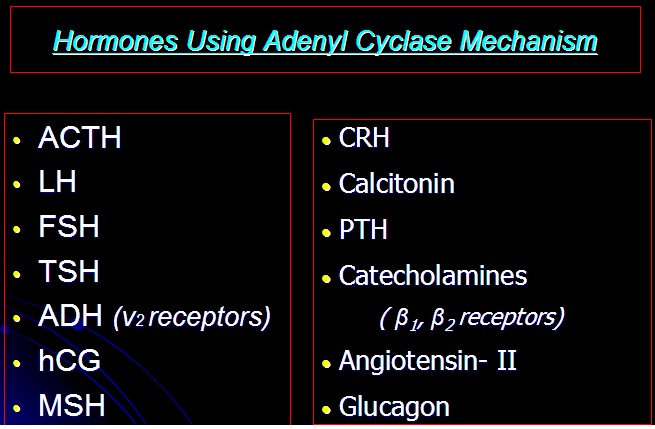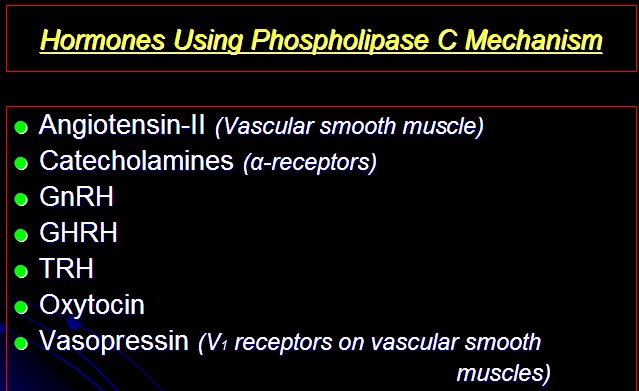Hormones are chemical messengers, directly secreted into the blood or extracellular fluid, which bind specific receptors on target cells, to initiate a cascade of events within the cells, producing the effect.
| Contents |
| Mechanism of Action |
| G Protein |
| 2nd messenger system |
| Ca Calmodulin Mechanism |
| Regulation |
| Clearance |
Mechanism of Action of Hormones:
Hormone Receptors:
Hormone receptors are membrane proteins which are specific for each hormone. Their sensitivity or responsiveness is determined by:
- Number of receptors; larger the number, greater is the response
- Affinity of receptors; higher the affinity, greater is the response
The sensitivity of receptors can be changed by the change in number of receptors, which can occur by:
- Increase or decrease in synthesis of receptors
- Increase of decrease in degradation of receptors
i.e. inactivation or activation of receptors by down regulation or up regulation. Example is the increase in tri-iodothyronine by a decrease in TRH receptors in anterior pituitary gland.
Down regulation of receptors can occur by:
- Inactivation of receptor molecules
- Inactivation of intracellular protein signaling molecule.
- Sequestration of receptors inside cell
- Destruction of receptors by lysosomes.the receptor.
- Decreased production of receptors
G Protein (Molecular Switch):
G-protein is the membrane bound protein which couples hormone receptor to the effector enzyme. It consists of three sub domains:
α-GDP or GTP, β and γ. The G-protein might be excitatory of inhibitory.
Mechanism of Activation of G-protein- coupled receptor:
The first step is the binding of hormone to the G protein (which is inactive) to the receptor. The G protein complex is activated. The α subunit dissociates and interacts with the membrane bound target protein (enzyme) to initiate intracellular signal.
Enzyme linked hormones:
The hormone binding site is located on the outside of the cell membrane and the catalytic or enzyme binding site on the inside. E.g. leptin, a cytokine, does not have enzymatic activity but signal through associated enzyme.
Site of Hormone Receptors:
Hormone receptors might be located:
1. In or on the surface of cell membrane, e.g. protein or peptide hormones and catecholamines.
2. In the cytoplasm, e.g. steroid hormones.
3. In the cell nucleus, e.g. thyroxine.
There are about 2000-100,000 receptors on each cell.
Mechanism of Action:
The endocrine gland releases hormones that bind with specific receptor on target cells and trigger intracellular signals by:
- Altering membrane permeability
- Acting through 2nd messenger system
- Activating specific genes to form new proteins
The intracellular signals produce physiological response.
1. Altering Membrane Permeability
The membrane permeability is altered by opening or closing or ion channels like Na+, K+ or Ca++ channels. Examples include the action of catecholamines and acetyl choline.
2. Acting through 2nd messenger system:
There are several types of 2nd messenger systems. These include:
- Adenyl cyclase- cAMP 2nd messenger system
- Jak Stat 2nd messenger system
- Phospholipase C 2nd messenger system
- Ca Calmodulin 2nd messenger system
Ca Calmodulin Mechanism:
Ca Calmodulin Mechanism operates in response to the Ca++ entry into the cell. The Ca++ entry may be initiated by:
- Change in membrane potential causing opening of Ca++ channels.
- Hormones interacting with membrane receptors causing opening of Ca++ channels in the cell membrane or endoplasmic reticulum or mitochondria.
Once calcium enters the cell, binding of Ca++ with calmodulin takes place. Then the activation or inactivation of calmodulin dependent protein kinase occurs.
3. Hormones Action through activation of Genes and Protein Synthesis:
The hormones also act through nuclear transcription and ribosomal translation. The proteins are synthesized which function as enzymes, transport proteins or structural proteins. Examples include the steroid hormones, cortisol, aldosterone and T4, etc.
Regulation of Hormone Secretions:
1. Nerural mechanisms:
Neural mechanisms involve the secretion of catecholamines by adrenal medulla.
2. Feedback mechanisms:
Feedback mechanisms involve the negative feedback mechanisms, which are more common, and the positive feedback mechanisms.
a. Long Loop Feedback:
Long loop feedback involves the hormone feedback all the way back to the hypothalamic-pituitary axis.
b. Short Loop Feedback
Short loop feedback involves the anterior pituitary hormone feedback on the hypothalamus to inhibit the hypothalamic releasing hormones.
c. Ultra Short Loop Feedback
In this case, the hypothalamic hormones inhibit their own secretions. E.g. GnRH.
Feedback loops are used to regulate the secretion of hormones in the hypothalamic-pituitary axis. An important example of the negative feedback loop is seen in control of thyroid hormone secretion.
Positive Feedback Mechanism:
Positive feedback mechanisms involve the effect of estrogen on secretion of FSH and LH by anterior pituitary as well as the effect of oxytocin.
Clearance of Hormones:
The clearance of hormones is determined by two factors:
1. Rate of secretion of hormone into the blood
2. Rate of removal of hormone from blood i.e. rate of metabolic clearance.
Hormones are cleared by:
- Metabolic destruction by tissues/ target cells.
- Binding with the tissues
- Excretion by liver into bile.
- Excretion by kidneys into urine.
Water soluble hormones(peptides and catecholamines) are degraded by enzymes in the blood or tissues and are excreted by kidneys or liver. They have a short half life.
Lipid soluble hormones(steroids) are protein bound and are cleared slowly.
 howMed Know Yourself
howMed Know Yourself



this website is very useful as it will help improve peoples I.Q and better resources for simple learners. I really enjoy it.
its a wonderful work site nd d above xplanation abt hormones is educative and wil help undergraduates lyk me in my xzams
Outstanding easy to understand thanks alot